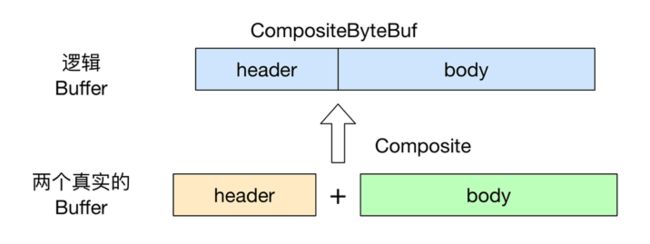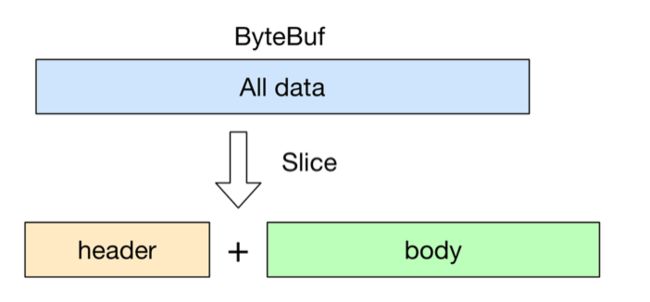根据 Wiki 对 Zero-copy 的定义:
即所谓的 Zero-copy, 就是在操作数据时, 不需要将数据 buffer 从一个内存区域拷贝到另一个内存区域. 因为少了一次内存的拷贝, 因此 CPU 的效率就得到的提升.
在 OS 层面上的 Zero-copy通常指避免在 用户态(User-space)与 内核态(Kernel-space)之间来回拷贝数据. 例如 Linux 提供的 mmap系统调用, 它可以将一段用户空间内存映射到内核空间, 当映射成功后, 用户对这段内存区域的修改可以直接反映到内核空间; 同样地, 内核空间对这段区域的修改也直接反映用户空间. 正因为有这样的映射关系, 我们就不需要在 用户态(User-space)与 内核态(Kernel-space)之间拷贝数据, 提高了数据传输的效率.
而需要注意的是, Netty 中的 Zero-copy与上面我们所提到到 OS 层面上的 Zero-copy不太一样, Netty的 Zero-coyp完全是在用户态(Java 层面)的, 它的 Zero-copy的更多的是偏向于 优化数据操作这样的概念.
Netty 的 Zero-copy体现在如下几个个方面:
Netty 提供了 CompositeByteBuf类, 它可以将多个 ByteBuf 合并为一个逻辑上的 ByteBuf, 避免了各个 ByteBuf 之间的拷贝.
通过 wrap 操作, 我们可以将 byte[] 数组、ByteBuf、ByteBuffer等包装成一个 Netty ByteBuf 对象, 进而避免了拷贝操作.
ByteBuf 支持 slice 操作, 因此可以将 ByteBuf 分解为多个共享同一个存储区域的 ByteBuf, 避免了内存的拷贝.
通过 FileRegion包装的FileChannel.tranferTo实现文件传输, 可以直接将文件缓冲区的数据发送到目标 Channel, 避免了传统通过循环 write 方式导致的内存拷贝问题.
下面我们就来简单了解一下这几种常见的零拷贝操作.
通过 CompositeByteBuf 实现零拷贝
假设我们有一份协议数据, 它由头部和消息体组成, 而头部和消息体是分别存放在两个 ByteBuf 中的, 即:
ByteBuf header = ...
ByteBuf body = ...
我们在代码处理中, 通常希望将 header 和 body 合并为一个 ByteBuf, 方便处理, 那么通常的做法是:
ByteBuf allBuf = Unpooled.buffer(header.readableBytes() + body.readableBytes());
allBuf.writeBytes(header);
allBuf.writeBytes(body);
可以看到, 我们将 header 和 body 都拷贝到了新的 allBuf 中了, 这无形中增加了两次额外的数据拷贝操作了.
那么有没有更加高效优雅的方式实现相同的目的呢? 我们来看一下 CompositeByteBuf是如何实现这样的需求的吧.
ByteBuf header = ...
ByteBuf body = ...
CompositeByteBuf compositeByteBuf = Unpooled.compositeBuffer();
compositeByteBuf.addComponents(true, header, body);
上面代码中, 我们定义了一个 CompositeByteBuf对象, 然后调用
public CompositeByteBuf addComponents(boolean increaseWriterIndex, ByteBuf... buffers) {
...
}
方法将 header与 body合并为一个逻辑上的 ByteBuf, 即:
不过需要注意的是, 虽然看起来 CompositeByteBuf 是由两个 ByteBuf 组合而成的, 不过在 CompositeByteBuf 内部, 这两个 ByteBuf 都是单独存在的, CompositeByteBuf 只是逻辑上是一个整体.
上面 CompositeByteBuf代码还以一个地方值得注意的是, 我们调用 addComponents(boolean increaseWriterIndex, ByteBuf... buffers)来添加两个 ByteBuf, 其中第一个参数是 true, 表示当添加新的 ByteBuf 时, 自动递增 CompositeByteBuf 的 writeIndex.
如果我们调用的是
compositeByteBuf.addComponents(header, body);
那么其实 compositeByteBuf的 writeIndex仍然是0, 因此此时我们就不可能从 compositeByteBuf中读取到数据, 这一点希望大家要特别注意.
除了上面直接使用 CompositeByteBuf类外, 我们还可以使用 Unpooled.wrappedBuffer方法, 它底层封装了 CompositeByteBuf操作, 因此使用起来更加方便:
ByteBuf header = ...
ByteBuf body = ...
ByteBuf allByteBuf = Unpooled.wrappedBuffer(header, body);
通过 wrap 操作实现零拷贝
例如我们有一个 byte 数组, 我们希望将它转换为一个 ByteBuf 对象, 以便于后续的操作, 那么传统的做法是将此 byte 数组拷贝到 ByteBuf 中, 即:
byte[] bytes = ...
ByteBuf byteBuf = Unpooled.buffer();
byteBuf.writeBytes(bytes);
显然这样的方式也是有一个额外的拷贝操作的, 我们可以使用 Unpooled 的相关方法, 包装这个 byte 数组, 生成一个新的 ByteBuf 实例, 而不需要进行拷贝操作. 上面的代码可以改为:
byte[] bytes = ...
ByteBuf byteBuf = Unpooled.buffer();
byteBuf.writeBytes(bytes);
可以看到, 我们通过 Unpooled.wrappedBuffer方法来将 bytes 包装成为一个 UnpooledHeapByteBuf 对象, 而在包装的过程中, 是不会有拷贝操作的. 即最后我们生成的生成的 ByteBuf 对象是和 bytes 数组共用了同一个存储空间, 对 bytes 的修改也会反映到 ByteBuf 对象中.
Unpooled 工具类还提供了很多重载的 wrappedBuffer 方法:
public static ByteBuf wrappedBuffer(byte[] array)
public static ByteBuf wrappedBuffer(byte[] array, int offset, int length)
public static ByteBuf wrappedBuffer(ByteBuffer buffer)
public static ByteBuf wrappedBuffer(ByteBuf buffer)
public static ByteBuf wrappedBuffer(byte[]... arrays)
public static ByteBuf wrappedBuffer(ByteBuf... buffers)
public static ByteBuf wrappedBuffer(ByteBuffer... buffers)
public static ByteBuf wrappedBuffer(int maxNumComponents, byte[]... arrays)
public static ByteBuf wrappedBuffer(int maxNumComponents, ByteBuf... buffers)
public static ByteBuf wrappedBuffer(int maxNumComponents, ByteBuffer... buffers)
这些方法可以将一个或多个 buffer 包装为一个 ByteBuf 对象, 从而避免了拷贝操作.
通过 slice 操作实现零拷贝
slice 操作和 wrap 操作刚好相反, Unpooled.wrappedBuffer可以将多个 ByteBuf 合并为一个, 而 slice 操作可以将一个 ByteBuf 切片为多个共享一个存储区域的 ByteBuf 对象.
ByteBuf 提供了两个 slice 操作方法:
public ByteBuf slice();
public ByteBuf slice(int index, int length);
不带参数的 slice方法等同于 buf.slice(buf.readerIndex(), buf.readableBytes())调用, 即返回 buf 中可读部分的切片. 而 slice(int index, int length)方法相对就比较灵活了, 我们可以设置不同的参数来获取到 buf 的不同区域的切片.
下面的例子展示了 ByteBuf.slice方法的简单用法:
ByteBuf byteBuf = ...
ByteBuf header = byteBuf.slice(0, 5);
ByteBuf body = byteBuf.slice(5, 10);
用 slice方法产生 header 和 body 的过程是没有拷贝操作的, header 和 body 对象在内部其实是共享了 byteBuf 存储空间的不同部分而已. 即:
通过 FileRegion 实现零拷贝
Netty 中使用 FileRegion 实现文件传输的零拷贝, 不过在底层 FileRegion 是依赖于 Java NIO FileChannel.transfer的零拷贝功能.
首先我们从最基础的 Java IO 开始吧. 假设我们希望实现一个文件拷贝的功能, 那么使用传统的方式, 我们有如下实现:
public static void copyFile(String srcFile, String destFile) throws Exception {
byte[] temp = new byte[1024];
FileInputStream in = new FileInputStream(srcFile);
FileOutputStream out = new FileOutputStream(destFile);
int length;
while ((length = in.read(temp)) != -1) {
out.write(temp, 0, length);
}
in.close();
out.close();
}
上面是一个典型的读写二进制文件的代码实现了. 不用我说, 大家肯定都知道, 上面的代码中不断中源文件中读取定长数据到 temp 数组中, 然后再将 temp 中的内容写入目的文件, 这样的拷贝操作对于小文件倒是没有太大的影响, 但是如果我们需要拷贝大文件时, 频繁的内存拷贝操作就消耗大量的系统资源了.
下面我们来看一下使用 Java NIO 的 FileChannel是如何实现零拷贝的:
public static void copyFileWithFileChannel(String srcFileName, String destFileName) throws Exception {
RandomAccessFile srcFile = new RandomAccessFile(srcFileName, "r");
FileChannel srcFileChannel = srcFile.getChannel();
RandomAccessFile destFile = new RandomAccessFile(destFileName, "rw");
FileChannel destFileChannel = destFile.getChannel();
long position = 0;
long count = srcFileChannel.size();
srcFileChannel.transferTo(position, count, destFileChannel);
}
可以看到, 使用了 FileChannel后, 我们就可以直接将源文件的内容直接拷贝(transferTo) 到目的文件中, 而不需要额外借助一个临时 buffer, 避免了不必要的内存操作.
有了上面的一些理论知识, 我们来看一下在 Netty 中是怎么使用 FileRegion来实现零拷贝传输一个文件的:
@Override
public void channelRead0(ChannelHandlerContext ctx, String msg) throws Exception {
RandomAccessFile raf = null;
long length = -1;
try {
// 1. 通过 RandomAccessFile 打开一个文件.
raf = new RandomAccessFile(msg, "r");
length = raf.length();
} catch (Exception e) {
ctx.writeAndFlush("ERR: " + e.getClass().getSimpleName() + ": " + e.getMessage() + '\n');
return;
} finally {
if (length < 0 && raf != null) {
raf.close();
}
}
ctx.write("OK: " + raf.length() + '\n');
if (ctx.pipeline().get(SslHandler.class) == null) {
// SSL not enabled - can use zero-copy file transfer.
// 2. 调用 raf.getChannel() 获取一个 FileChannel.
// 3. 将 FileChannel 封装成一个 DefaultFileRegion
ctx.write(new DefaultFileRegion(raf.getChannel(), 0, length));
} else {
// SSL enabled - cannot use zero-copy file transfer.
ctx.write(new ChunkedFile(raf));
}
ctx.writeAndFlush("\n");
}
上面的代码是 Netty 的一个例子, 其源码在 **netty/example/src/main/java/io/netty/example/file/FileServerHandler.java**
可以看到, 第一步是通过 `RandomAccessFile`打开一个文件, 然后 Netty 使用了 `DefaultFileRegion`来封装一个 `FileChannel`即:
`new DefaultFileRegion(raf.getChannel(), 0, length)`
当有了 FileRegion 后, 我们就可以直接通过它将文件的内容直接写入 Channel 中, 而不需要像传统的做法: 拷贝文件内容到临时 buffer, 然后再将 buffer 写入 Channel. 通过这样的零拷贝操作, 无疑对传输大文件很有帮助.
转自:https://www.jianshu.com/p/1d1fa2fe1ed9
* * *
*欢迎加群交流,QQ群:66728073,197321069,398808948
雪奈尔蓝牙键盘,点击这里查看购买



